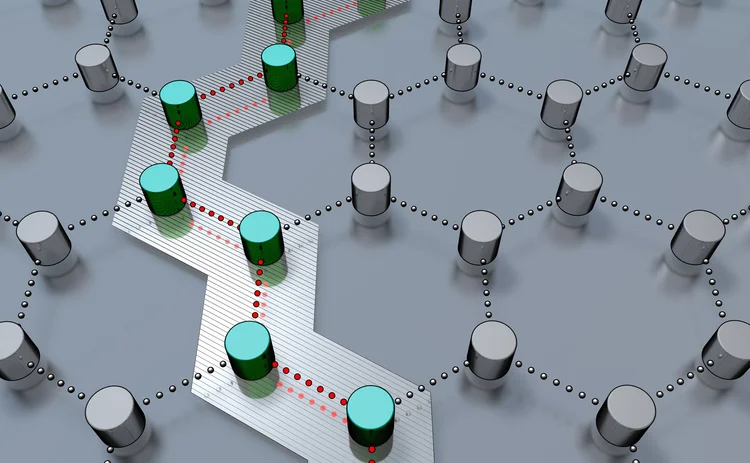Blockchain Frameworks Move Forward with Partnerships and Production Releases
Hyperledger Fabric has released its production-ready version 1.0, as R3 partners with Intel

Hyperledger has made Hyperledger Fabric 1.0 available for the development of applications, products and solutions on an open-source basis.
Hyperledger Fabric—hosted by The Linux Foundation—offers modular architecture for plug-and-play components, and leverages smart contracts it calls “chaincode” for the system’s application logic. The technology was incubated 16 months ago and placed on active status in March 2017.
Brian Behlendorf, executive director of Hyperledger, said the release of the technology is a milestone for distributed-ledger technology.
“After over a year of public collaboration, testing, and validation in the form of proof of concepts and pilots, consumers and vendors of technology based on Hyperledger Fabric can now advance to production deployment and operations,” Behlendorf. “I look forward to seeing even more products and services being powered by Hyperledger Fabric in the next year and beyond.”
The technology was developed by engineers from the Hyperledger community which includes CLS, the Depository Trust and Clearing Corporation (DTCC), Digital Asset, GE, the Linux Foundation, State Street, IBM, and SAP. In total, around 159 developers worked on the project.
Several Hyperledger community members have already begun using Hyperledger Fabric for their applications. CLS, for example, announced in September last year that it intends to develop a payments-netting service on Hyperledger Fabric and ANZ Banking Group is running a proof of concept to digitize guarantees for property companies.
“As a founding member of the Hyperledger community, ANZ is excited to be using Hyperledger Fabric 1.0 in its latest customer proof-of-concept, which has enabled the digitization of the bank guarantee, or standby letter of credit as they are known in the US, for property companies in Australia,” said Nigel Dobson, general manager for wholesale digital and digital banking at ANZ Banking Group, in an accompanying statement
Separately, R3 announced it is collaborating with Intel to strengthen data privacy and security for its own blockchain framework, Corda, which entered into public beta in June.
The collaboration adds elements of Intel’s security and privacy toolkit for Corda’s need-to-know feature, which assures confidentiality in trades by selectively sending information to parties who require it.
R3’s lead platform engineer Mike Hearn said the consortium is continually working on solutions to better protect privacy on the ledger.
“By partnering with Intel, we will be able to give Corda users more class-leading features as we continue to set the standard in distributed ledger technology data privacy,” Hearn said in a statement. “Corda addresses multiple problems identified by our 80-plus members across the globe but transaction privacy is usually the top issue blocking real-world deployment.”
Only users who have a paid subscription or are part of a corporate subscription are able to print or copy content.
To access these options, along with all other subscription benefits, please contact info@waterstechnology.com or view our subscription options here: http://subscriptions.waterstechnology.com/subscribe
You are currently unable to print this content. Please contact info@waterstechnology.com to find out more.
You are currently unable to copy this content. Please contact info@waterstechnology.com to find out more.
Copyright Infopro Digital Limited. All rights reserved.
As outlined in our terms and conditions, https://www.infopro-digital.com/terms-and-conditions/subscriptions/ (point 2.4), printing is limited to a single copy.
If you would like to purchase additional rights please email info@waterstechnology.com
Copyright Infopro Digital Limited. All rights reserved.
You may share this content using our article tools. As outlined in our terms and conditions, https://www.infopro-digital.com/terms-and-conditions/subscriptions/ (clause 2.4), an Authorised User may only make one copy of the materials for their own personal use. You must also comply with the restrictions in clause 2.5.
If you would like to purchase additional rights please email info@waterstechnology.com
More on Trading Tech
WatersTechnology latest edition
Check out our latest edition, plus more than 12 years of our best content.
A new data analytics studio born from a large asset manager hits the market
Amundi Asset Management’s tech arm is commercializing a tool that has 500 users at the buy-side firm.
How exactly does a private-share trading platform work?
As companies stay private for longer, new trading platforms are looking to cash in by helping investors cash out.
Accelerated clearing and settlement, private markets, the future of LSEG’s AIM market, and more
The Waters Cooler: Fitch touts AWS AI for developer productivity, Nasdaq expands tech deal with South American exchanges, National Australia Bank enlists TransFicc, and more in this week’s news roundup.
Inside the company that helped build China’s equity options market
Fintech firm Bachelier Technology on the challenges of creating a trading platform for China’s unique OTC derivatives market.
Experts say HKEX’s plan for T+1 in 2025 is ‘sensible’
The exchange will continue providing core post-trade processing through CCASS but will engage with market participants on the service’s future as HKEX rolls out new OCP features.
‘The opaque juggernaut’: Private credit’s data deficiencies become clear
Investor demand to take advantage of the growing private credit markets is rising, despite limited data, trading mechanisms, and a lack of liquidity.
Overnight trading blocked, consolidated tapes, BlackRock’s Larry Fink, data costs, and more
The Waters Cooler: Deutsche Börse provides crypto custody, FIS has a new GenAI tool, and some M&A activity in this week’s news round-up.







